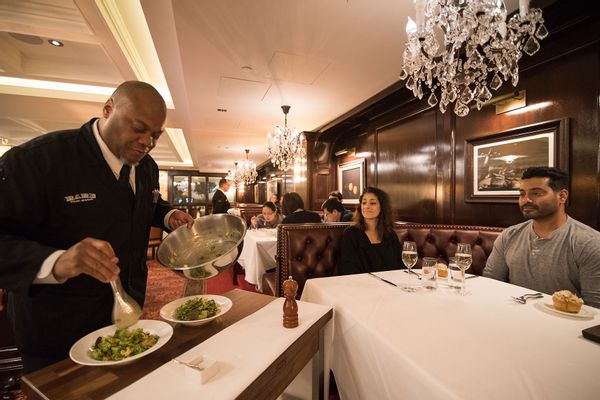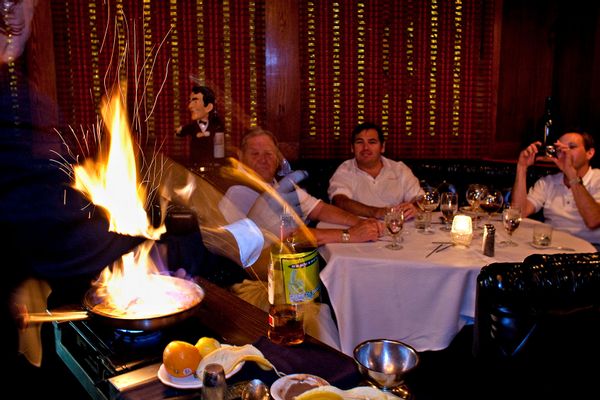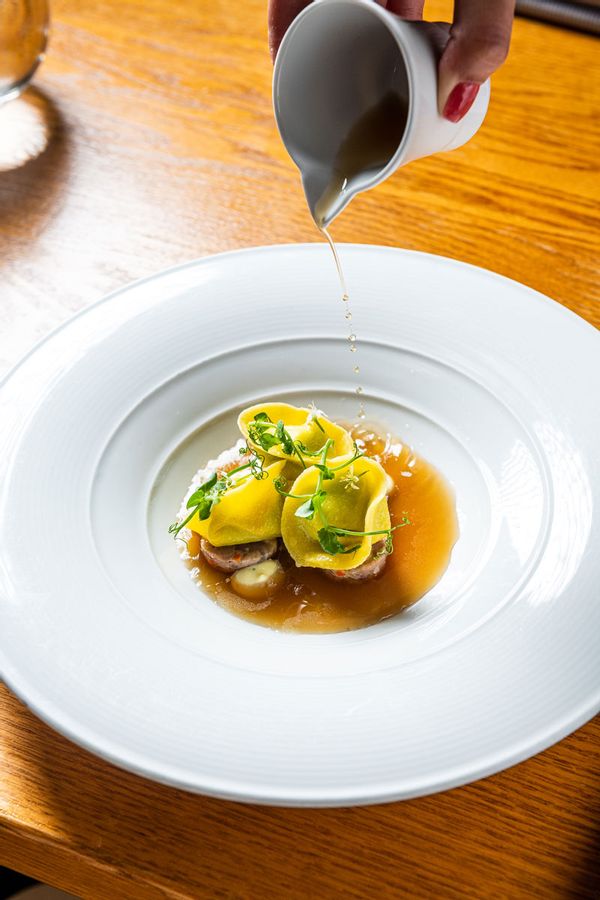
I adore tableside service. There are the furtive glances between diners as the cook or server partakes in the cooking, pouring or presentation; the formality of it and the way the guests sit up in their chairs in expectation; the perma-smile often plastered on everyone's faces (even if the service actually goes a bit too long and a bit of fatigue is creeping through); the repeated "thank you's."
The extra layer helps to mark the moment — which might take as little as 90 seconds — as something that is exciting, rare and little special.
There's something theatrical, a moment of "pomp and circumstance" which really elevates a simple, everyday "dinner out" into something memorable, something special, something you'll refer to a few years down the road like "hey, remember that time that we . . . " Even something as simple as a steaming-hot fajita plate or dry ice cocktails will often elicit lots of "ohhhs" and "ahhhs," and at the end of the day, that's always a fun thing to partake it. It's like clapping for the pilot after the plane lands.

So why, then, is tableside service still seemingly such a rarity? Is it an extra burden or labor on the kitchen staff? Is it frustrating for the front-of-house staff? Do guests get a little skittish, anxious or even shirk back a bit as the cart wheels its way over to the table, focusing some extra attention on them? Is the pricing too intimating? Does schlepping out tools and ingredients readily available in the kitchen and producing dishes in the dining room prove counterproductive?
To be clear, not everyone loves tableside service as much as I do. There are certainly some detractors. Think of hibachi: there's a performative energy necessary in order to make it a celebratory situation. If the server or cook seems disinterested, the diners are going to pick up on that. Then there are the diners who would rather sink into the floor than have any kind of extra attention put on them.

But most restaurant professionals who offer tableside service view it as an extension of true hospitality. Gowri Chandra notes the history of this in Food & Wine, where she wrote that in the Middle Ages meat would be carved at a special event before dining. "It was here," Chandra wrote. "That serving became a ritual in itself as a prelude to eating."
She continued: "Sometimes, the performance is not so much a statement of refinement as it is a gesture of hospitality."
This point was echoed by Bar director Judy Elahi of Gravitas — a Michelin-starred, Modern American restaurant in Washington, DC.
"My origins on tableside service stem from my love of theater. In high school, I was the 'lead prop techie,'" Elahi told Salon Food. "I was very selective with which props worked for the story line and concept of the show. For me, hospitality is all about the show. When we open for service, we open the curtains to our show. Also everyone enjoys seeing a personalized presentation . . . it makes their experience more engaging."
Gravitas' owner and executive chef Matt Baker noted that tableside service allows guests to be integrated into the kitchen, in a way.
"The experience is truly engaging, from the presentation of the plate or bowl, to the description of the ingredients and process, and then the scent of the sauce or soup being poured on top," he said. "The element of engagement is what keeps our guests intrigued and wowed!" Furthermore, it allows for guests to ask questions in real time, which can also help deepen that connection between the staff, the food and the diners.
"Top Chef" alum Manuel Trevino is the current Vice President of Culinary at Rosa Mexicano, which is a Mexican-American restaurant chain. He stated that tableside service is "absolutely no burden at all," and the team is set up "for success with custom-made tableside cart with all of the tools, toppings, and serviceware needed."
One issue that some diners may have with tableside service is the price Many tableside preparations — possibly sans hibachi, guacamole, some desserts and the classic Caesar salad — incur quite a lofty price tag or are only offered at especially high-end restaurants. It can also feel stuffy, ritzy or, in cases when it runs on too long, just generally seem like it's "too much." This was the topic of a 2018 Kate Krader story in Bloomberg which specifically references dining experiences that include jazz hands, rolling carts and fancy places.

Elahi said that tableside cocktails will always be slightly higher in price because they need to have the staff to do the presentation.
"Anything that involves someone at your table will inherently cost more," she said. "It's important to train your whole team on how to do the presentations, so if needed anyone can jump in."
However, most contemporary restaurants that offer tableside service aren't doing so in order just to charge customers extra for an experience. Matt Baker said that at Gravitas, it is essential to the interpretation and enjoyment of some dishes.
"Tableside pours are a great way for us to present the elements of dishes in pristine form, before adding an element that may cover parts of the dish," he said. "It allows guests to be able to really see all of the ingredients and garnishes before the sauce or soup is poured over the dish."

Right now, Gravitas is offering 3 tableside items: hamachi and wagyu chef counter options, a chilled zucchini gazpacho, as well as an English pea tortellini with pork trotter terrine and parmesan pork brodo. Each offers a tableside pour which adds some dazzle (plus flavor, aroma, color and overall presentation) to the dishes.
According to Trevino, Josefina Howard — who founded Rosa Mexicano in the 1980s — was "passionate about Mexican cuisine and culture; sharing that love and enthusiasm with her guests is core to Rosa Mexicano's timeless appeal." She was also one of the first restaurateurs to offer tableside guacamole service in the United States.
"Dining has become much more experiential," Trevino said. "We are seeing a huge renaissance in tableside service, as guests dine out as much to be fed as to be entertained. Tableside service is an amazing way for guests to engage with our team, to learn something new and to have some fun. This offers some theater, a bit of a show, along with a fantastic meal."
In addition to the guacamole service option, Rosa Mexicano also offers a queso pour option.
"Our queso is incredibly popular and guests love adding it to honestly any menu item and our team is always glad to pour tableside to add to the fun," Trevino said. Going forward, Rosa Mexicano is also beginning to work on outdoor taco carts on their outdoor patios, as well as tableside margarita presentations.

No matter if you're catching shrimp tails in your mouth at a local hibachi place or dishing out tons of money for a progressive tasting-menu that features elaborate, high-end tableside service, there's an aspect of universality that I hope tableside service can soon accomplish. One might argue that the entire notion of an "open kitchen" — which has exploded in popularity over the past decade or so — might also feel like quasi-tableside, in a way. You see the whole song and dance occurring in front of you and while it may not be legitimately "tableside," the experience is similar.
Regardless, tableside service deserves more widespread acclaim and appeal, and I can only hope it can achieve — because we all deserve something special when we go out to eat.







